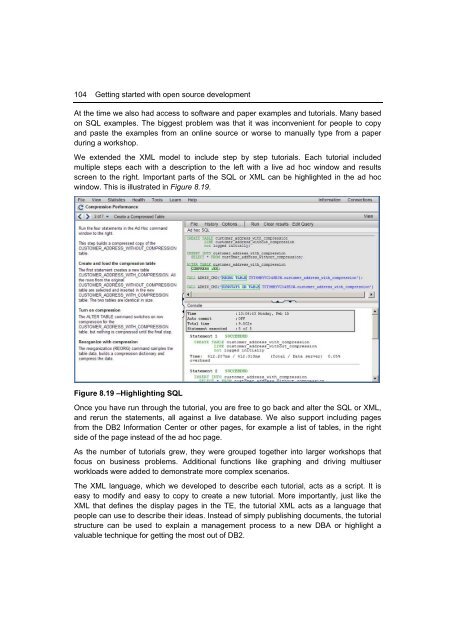Getting Started with Open Source Development
Create successful ePaper yourself
Turn your PDF publications into a flip-book with our unique Google optimized e-Paper software.
104 <strong>Getting</strong> started <strong>with</strong> open source development<br />
At the time we also had access to software and paper examples and tutorials. Many based<br />
on SQL examples. The biggest problem was that it was inconvenient for people to copy<br />
and paste the examples from an online source or worse to manually type from a paper<br />
during a workshop.<br />
We extended the XML model to include step by step tutorials. Each tutorial included<br />
multiple steps each <strong>with</strong> a description to the left <strong>with</strong> a live ad hoc window and results<br />
screen to the right. Important parts of the SQL or XML can be highlighted in the ad hoc<br />
window. This is illustrated in Figure 8.19.<br />
Figure 8.19 –Highlighting SQL<br />
Once you have run through the tutorial, you are free to go back and alter the SQL or XML,<br />
and rerun the statements, all against a live database. We also support including pages<br />
from the DB2 Information Center or other pages, for example a list of tables, in the right<br />
side of the page instead of the ad hoc page.<br />
As the number of tutorials grew, they were grouped together into larger workshops that<br />
focus on business problems. Additional functions like graphing and driving multiuser<br />
workloads were added to demonstrate more complex scenarios.<br />
The XML language, which we developed to describe each tutorial, acts as a script. It is<br />
easy to modify and easy to copy to create a new tutorial. More importantly, just like the<br />
XML that defines the display pages in the TE, the tutorial XML acts as a language that<br />
people can use to describe their ideas. Instead of simply publishing documents, the tutorial<br />
structure can be used to explain a management process to a new DBA or highlight a<br />
valuable technique for getting the most out of DB2.

















